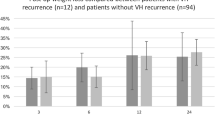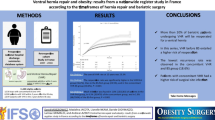Abstract
Introduction
Ventral hernias are not uncommon in the bariatric population. Their management is technically demanding and remains controversial. Hernia complications can be lethal after bariatric surgery (BS). We herein report our experience with concomitant BS and ventral hernia repair (VHR).
Methods
We performed a retrospective analysis of a prospectively maintained database queried for combined procedures. Hernias were repaired after complete reduction (when the defect was not empty) using a dual mesh fixed to the abdominal wall with absorbable tackers. Data collected included demographics, anthropometrics, co-morbidities, peri-operative course, and intermediate weight loss and co-morbidity status.
Results
Between 2007 and 2012, a total of 54 patients (34 females, mean body mass index 44.2 kg/m2) underwent concomitant BS and VHR. The vast majority of procedures were laparoscopic sleeve gastrectomies (N = 48; 89 %). Others included laparoscopic Roux-en-y gastric bypass (RYGB), open RYGB, and laparoscopic gastric banding (two each). Six patients had complications (11 %): three leaks, two abdominal wall hematomas, and one pulmonary embolism. Hernia recurrence was noted in one patient (1.8 %). Average excess weight loss post-surgery was 49.9 ± 10.3 and 57.7 ± 9.2 % at 6 and 12 months, respectively. The total number of pre-operative co-morbidities was 110. At 12-month follow-up, 50 % (N = 56) were completely resolved and 38 % (N = 42) were improved.
Conclusion
Concomitant BS and VHR is feasible and safe, obviating the need for two separate procedures while not hampering the outcome of either. Complication rates for the combined surgery do not seem to be adversely affected.


Similar content being viewed by others
References
Sugerman HJ, Kellum JM Jr, Reines HD, DeMaria EJ, Newsome HH, Lowry JW (1996) Greater risk of incisional hernia with morbidly obese than steroid-dependent patients and low recurrence with prefascial polypropylene mesh. Am J Surg 171:80–84
Anthony T, Bergen PC, Kim LT, Henderson M, Fahey T, Rege RV, Turnage RH (2000) Factors affecting recurrence following incisional herniorrhaphy. World J Surg 24:95–100
Datta T, Eid G, Nahmias N, Dallal RM (2008) Management of ventral hernias during laparoscopic gastric bypass. Surg Obes Relat Dis 4:754–757
Varela JE, Hinojosa M, Nguyen N (2009) Correlations between intra-abdominal pressure and obesity-related co-morbidities. Surg Obes Relat Dis 5:524–528
Brolin RE (1996) Prospective, randomized evaluation of midline fascial closure in gastric bariatric operations. Am J Surg 172:328–331
Capella RF, Iannace VA, Capella JF (2007) Reducing the incidence of incisional hernias following open gastric bypass surgery. Obes Surg 17:438–444
Owens M, Barry M, Janjua AZ, Winter DC (2011) A systematic review of laparoscopic port site hernias in gastrointestinal surgery. Surgeon 9:218–224
Praveen Raj P, Senthilnathan P, Kumaravel R, Rajpandian S, Rajan PS, Anand Vijay N, Palanivelu C (2012) Concomitant laparoscopic ventral hernia mesh repair and bariatric surgery: a retrospective study from a tertiary care center. Obes Surg 22:685–689
Eid GM, Mattar SG, Hamad G, Cottam DR, Lord JL, Watson A, Dallal RM, Schauer PR (2004) Repair of ventral hernias in morbidly obese patients undergoing laparoscopic gastric bypass should not be deferred. Surg Endosc 18:207–210
Geisler DJ, Reilly JC, Vaughan SG, Glennon EJ, Kondylis PD (2003) Safety and outcome of use of nonabsorbable mesh for repair of fascial defects in the presence of open bowel. Dis Colon Rectum 46:1118–1123
Newcomb WL, Polhill JL, Chen AY, Kuwada TS, Gersin KS, Getz SB, Kercher KW, Heniford BT (2008) Staged hernia repair preceded by gastric bypass for the treatment of morbidly obese patients with complex ventral hernias. Hernia 12:465–469
Rao RS, Gentileschi P, Kini SU (2011) Management of ventral hernias in bariatric surgery. Surg Obes Relat Dis 7:110–116
Sukeik M, Alkari B, Ammori BJ (2007) Abdominal wall hernia during laparoscopic gastric bypass: a serious consideration. Obes Surg 17:839–842
Disclosures
Drs. Asnat Raziel, Nasser Sakran, Amir Szold, and David Goitein have no conflict of interest or financial ties to disclose.
Author information
Authors and Affiliations
Corresponding author
Rights and permissions
About this article
Cite this article
Raziel, A., Sakran, N., Szold, A. et al. Concomitant bariatric and ventral/incisional hernia surgery in morbidly obese patients. Surg Endosc 28, 1209–1212 (2014). https://doi.org/10.1007/s00464-013-3310-z
Received:
Accepted:
Published:
Issue Date:
DOI: https://doi.org/10.1007/s00464-013-3310-z




